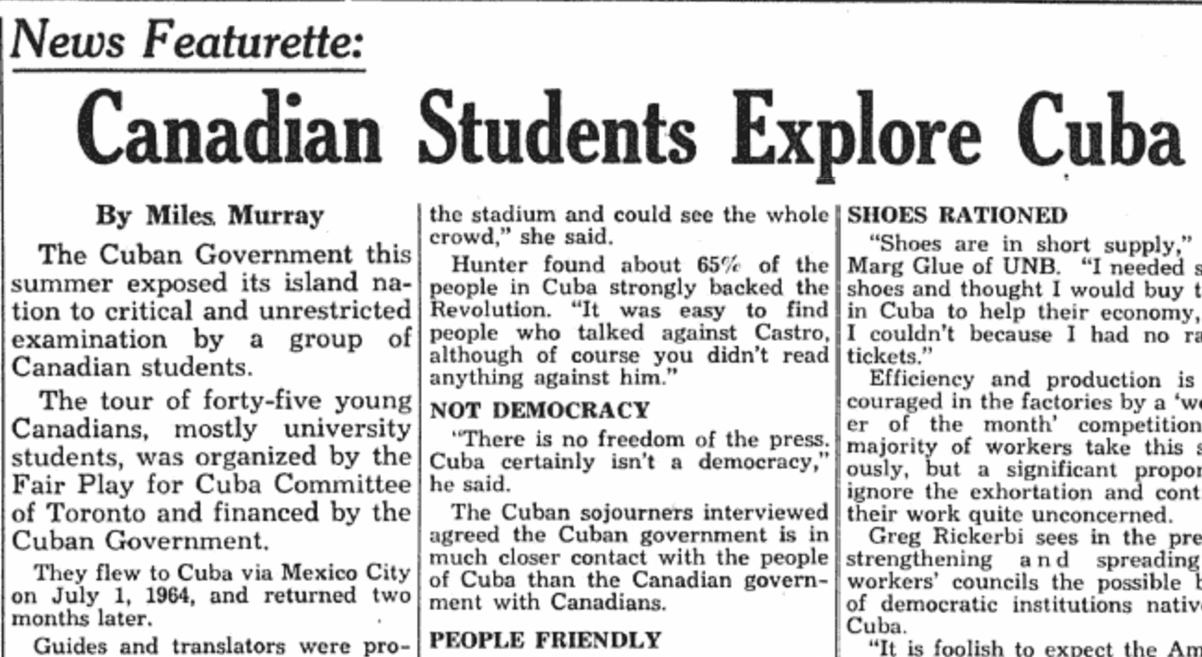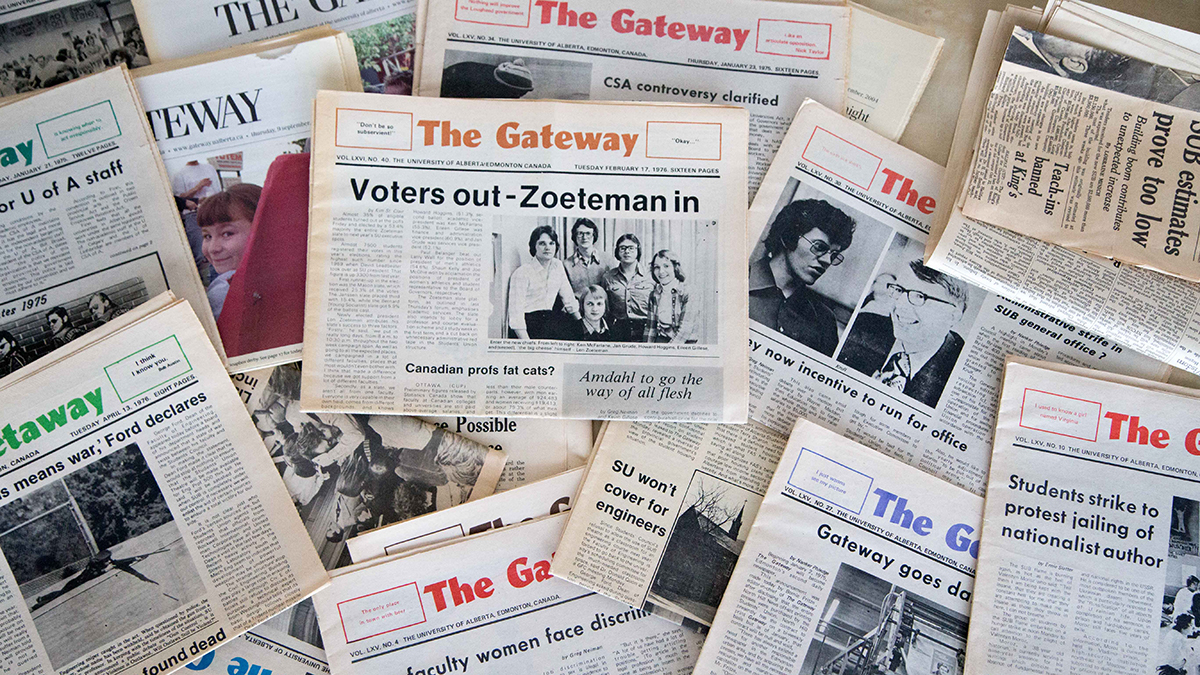Throwback: Canadian Students Explore Cuba
 Mitch Sorensen
Mitch SorensenThrowback is a semi-regular feature where we dive into The Gateway vault to find historical, noteworthy, or just plain weird stories from our past. This article comes from the October 2, 1964 issue of The Gateway, and was written by Miles Murray.
Our back issues dating to 1910 can be found in print at the U of A Library, as well as online at Peel’s Prairie Provinces archive.
The Cuban Government this summer exposed its island nation to critical and unrestricted examination by a group of Canadian students.
The tour of forty-five young Canadians, mostly university students, was organized by the Fair Play for Cuba Committee of Toronto and financed by the Cuban Government.
They flew to Cuba via Mexico City on July 1, 1964, and returned two months later.
Guides and translators were provided for the tour, but members were free to branch out on their own.
Robin Hunter, the only Edmontonian on the tour says the island “is not as much under the thumb of Russia today as it was under the thumb of the USA before the revolution.”
PRECAUTIONS
Uniformed and armed militia, both men and women, are seen everywhere in Cuba. Every factory has its armed guard, and the guide of a side trip some of the Canadians took slept with a loaded revolver under his pillow.
The precautions are taken because the Cuban people think an attack will come at any moment.
“They know that the attack will be by Cuban exiles, but they also know it will really be by the USA,” says Hunter.
A speech by Fidel Castro July 26, an important day in the history of the Revolution, was a stimulating experience for Faye Fraser of the University of Manitoba.
CASTRO SPEAKS
The speech, one of Castro’s shorter specimens, only three and one-half hours, was heard by a crowd of 10,000.
“There was a dialogue or a conversation between Castro and the people,” explained Nancy Duggan who works in the SCM Book Room and peace movement in Toronto.
“As Fidel explained an action of the government or the need for hard work on the part of the people or the shortage of shoes in Cuba, the crowd would response with ‘si’ and ‘no’ and other less articulated expressions.
“Cubans love to be together in a way that is unknown in North America,” says Miss Fraser.
“The huge crowd for Fidel’s speech was directed easily by a small number of female Militia — no Beatlemania!”
“As guests we sat behind Fidel in the stadium and could see the whole crowd,” she said.
Hunter found about 65% of the people in Cuba strongly backed the Revolution. “It was easy to find people who talked against Castro, although of course you didn’t read anything against him.”
NOT DEMOCRACY
“There is no freedom of the press. Cuba certainly isn’t a democracy,” he said.
The Cuban sojourners interviewed agreed the Cuban government is in much closer contact with the people of Cuba than the Canadian government with Canadians.
PEOPLE FRIENDLY
Greg Rickerbi, who learned enough Spanish during the tour to get by without an interpreter, found the Cuban people friendly and eager to help him learn Spanish and get around the country.
He became well-acquainted with several anti-Revolutionaries.
For the most part, Rickerbi said, these people are of the dispossessed class, those who had wealth and positions taken from them by the Revolution.
“Almost without exception they want to get out of Cuba, and do not take part in the many parades, demonstrations and extra work excursions the Cubans use to express eagerness for the forward movement of the Revolutionary programs.”
“The U.S. blockade has turned the people towards Castro and violently against the U.S. government, the Edmonton Traveller said.
“The people aren’t anti-American. They are anti-American government.”
“The U.S. government is forcing Cuba into Russia’s arms.”
Many Cuban children, for the first time, are getting a chance to get an education.
Another ‘first time’ is medical attention for people in rural areas.
Students graduating from medical must serve three years in rural areas as a service to the government which has eliminated their tuition fees, said Mr. Hunter.
FEW COMMUNISTS
Not everyone in Cuba is communist, in fact very few are.
Many students are studying Marxism in order to become communist. Meanwhile Russians are not well accepted by Cubans.
“Their culture is too different,” explained Nancy Duggan.
“They’ll never make good communists,” she said, “They’re too carefree and easygoing. Cubans are western world and North American.”
SHOES RATIONED
“Shoes are in short supply,” said Marg Glue of UNB. “I needed some shoes and thought I would buy them in Cuba to help their economy, but I couldn’t because I had no ration tickets.”
Efficiency and production is encouraged in the factories by a ‘worker of the month’ competition. A majority of the workers take this seriously, but a significant proportion ignore the exhortation and continue their work quite unconcerned.
Greg Rickerbi sees in the present strengthening and spreading of workers’ councils the possible birth of democratic institutions native to Cuba.
“It is foolish to expect the American institutions, developed in the Atlantic Seaboard situation of the 1700’s to work in the totally different situation of Cuba in the mid-twenties,” he said.
EDUCATIONAL ADVANCES
The advances in education are spectacular according to most of the Canadian group interviewed.
All the military establishments of the Batista regime as well as many of the large houses appropriated from rich Cubans and Americans have been converted to classrooms.
This conversion accounts for the multifold increase in number of classrooms, although new structures are being created at a rapid rate, particularly in the rural areas.
The whole tour group spent two weeks working at the construction of a school in an isolated hill region.
This was at the request of the Canadians who wanted to get to know some Cubans by working with them rather than just touring.
They found teachers usually young and enthusiastic. Many are teachers and students at the same time as they quickly make use of their new learning.
PLEASING ARCHITECTURE
The Canadians found Cuban architecture very pleasing.
New types of structures are being tried everywhere in the government developments.
Cuban houses are generally small and half-walled for ventilation.
They don’t need or use houses like we do in Canada, spending most of their time out-of-doors, meeting in groups on verandas, front lawns and on the streets, one student said.
Some thought they would like to live in Cuba for a while, and others would not.
The political situation, the climate and the people made different impressions on them and has resulted in different attitudes, but the tour has been termed a success.




